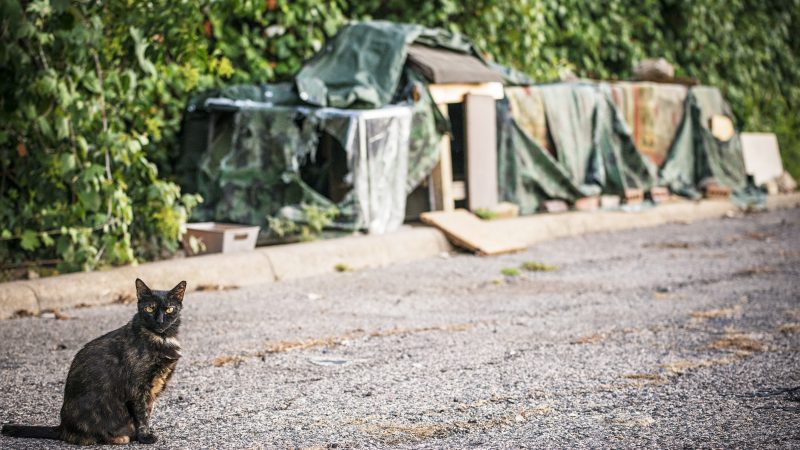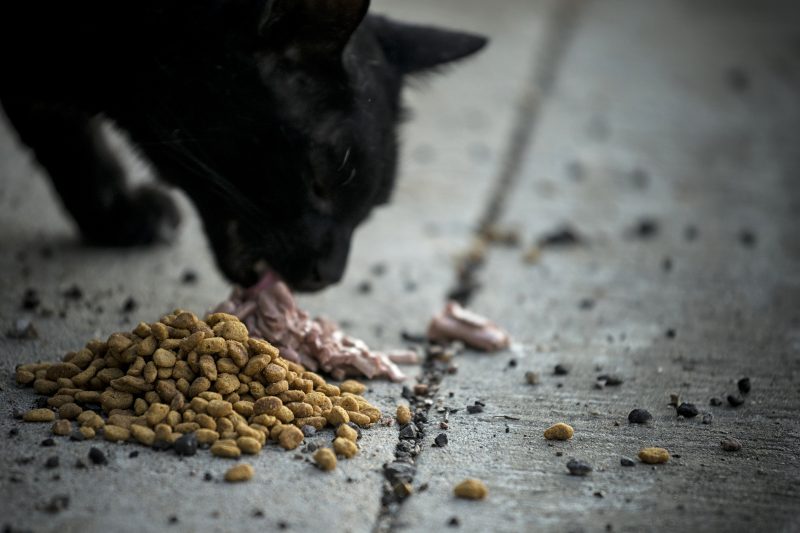
Photography by Danny Fulgencio.
On a wall at Sally and Chris Skoog’s Belmont Avenue home hangs a photo of Murray the Cat, a big orange tabby with a human-like cry and a nub of a tail that would whip around when he allowed human hands to stroke his fur. It was his untimely death at the paws of a coyote that inspired the Skoogs to formally establish a feral cat colony — one that now thrives and gives Murray’s compadres a better life.
Murray was one of many cats who hung around a little white house on Cecille Avenue, not far from the Skoogs. The resident was a “generous and kind cat lover,” remembers Sally, one who took good care of his own cats and ended up feeding feral cats who discovered the food source.
The cats would eventually number about 25, with continuous litters of kittens. Neighbors, the Skoogs among them, wanted to help, but were at a loss since the cats were cautious and fearful of humans.
After the trauma of Murray’s death, the Skoogs got busy, with Skoog — Chris Skoog is widely known by his last name — diving into research to find out how they could lend some help to these cats.
“We really wanted to thwart the colony expansion, and we struggled with the best way to do that,” he says. “Many times, people think that these strays can be adopted, but growing up in a community cat colony, many are not good adoption candidates. The best way to keep them healthy is to vaccinate and spay and neuter to avoid colony growth.”
According to the SPCA, spaying and neutering cats is the most humane and effective way to limit the populations of free roaming cats. Bonus: The cats control the rat population.
Ultimately, the Skoogs connected with Tina Hoskins at Dallas Pets Alive. “She taught us everything we know about trap, neuter, return, aka TNR,” Skoog says. Cats are humanely trapped, neutered by a veterinarian and, once healed, returned to their familiar territory.
The trapping is fairly tricky, as the Skoogs soon learned, and they became known in the neighborhood as “The Cat Stalkers.” Many an evening, they would quietly set up traps, baiting them with canned mackerel, which they called “the most malodorous food you can ever imagine.”

Then they waited nearby — sometimes in lawn chairs, sometimes hiding. When the unsuspecting cat succumbed to the temptation of the fragrant fish, the trap door would slam shut. The Skoogs would toss a cover over the trap to calm the cat and cart the feline to their home to fast overnight before surgery the next day at SPCA.
Within a year, they were able to achieve 100% colony spay/neuter status. Word spread, and they have been involved in fixing about 50 other area cats.
The Skoogs stress that lots of neighbors helped out initially and continue to help with feeding and generally maintaining Cecille Avenue Community Cat Colony, its official name as registered with the city. And the resident of the little white house? He was “instrumental” in trapping.
Unfortunately, the gentleman had to move, and the property was demolished a few months ago, so the colony is being slowly migrated up the alley behind Belmont Avenue toward Alderson. Walk down the alley, and you’ll notice several feeding stations supplied with bowls of food and water, as well as a good number of shelters/houses, one of which has a tiny welcome mat at the door. Blue shutters adorned with white flowers frame the window of the little cat cottage.
Approach quietly, and you’ll be treated to the sight of several tuxedo cats milling about. Most are skittish, but one or two might allow some quick petting.
The colony is truly a community effort. Neighbors lend their alley access to the colony for the feeding stations and cat houses, and several donate food and time. Cynthia Anzaldua is a helper who feeds the cats each morning. “After the house was demolished, I worried about what would happen with the cats and reached out to Sally to ask what we could do,” she says.
She adds, “I check on them throughout the day to make sure they’re fine, and often people stop and ask about them, and many wonderful neighbors have volunteered to bring food and even shelter if needed. The neighborhood has been absolutely wonderful.”
Count Allie Goetz as another neighbor who has tended to the cats for many years, even at one point making an attempt at TNR. “But we were floundering until Skoog and Sally stepped in,” she says. “They spent hours getting the cats used to them, trapping them, giving them a safe place to stay while they recuperated, etc.”
“When the little (white) house was still standing across the street,” Goetz recalls. “I used to watch all kinds of people stop to interact with the cats, ready to fly across if anyone was going to be hurtful. I never saw that. I saw surprise at the number, concern about their care, and joy in their presence. The neighborhood is their home, and we are their protectors.”





